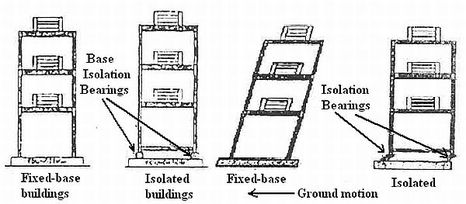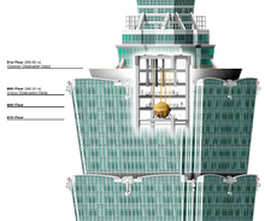Science and Design
Earthquake Engineering and Newton's Laws of Motion
Newton's first law of motion states:
"Every body persists in its state of being at rest or of moving uniformly straight forward, except insofar as it is compelled to change its state by force impressed."
Basically, an object in motion will stay in motion, and an object at rest will stay at rest, unless acted on by an outside force. In other words, all objects are "lazy" and resist a change in motion. In theory, a building will stay in place forever, unless something moves it or knocks it down. In this case, that "outside force" would be an earthquake. To make a building resistant to earthquakes, one must either increase the building's resistance of a change in motion, or engineer to allow the building to move slightly with the earthquake.
"Every body persists in its state of being at rest or of moving uniformly straight forward, except insofar as it is compelled to change its state by force impressed."
Basically, an object in motion will stay in motion, and an object at rest will stay at rest, unless acted on by an outside force. In other words, all objects are "lazy" and resist a change in motion. In theory, a building will stay in place forever, unless something moves it or knocks it down. In this case, that "outside force" would be an earthquake. To make a building resistant to earthquakes, one must either increase the building's resistance of a change in motion, or engineer to allow the building to move slightly with the earthquake.
Base Isolation

One of the most common components in basic earthquake resistant buildings is a base isolation system. Base isolation systems float buildings above their bases by resting them on top of a system of shock-absorbing objects, such as bearings, padded cylinders, or springs. A popular choice for shock absorbing objects are lead-rubber bearings, which are solid lead cores covered in layers of rubber and steel. The core makes the bearing strong, while the rubber and steel give it horizontal flexibility. The method of base isolation allows the foundation to move without disturbing the actual building greatly. This prevents damage and deformation of the structure.
Structural Steel
Structural steel is a material used in earthquake resistant buildings. It is popular because of it flexibility and ability to withstand impacts that would usually end in large deformations. Structural steel comes in various shapes, such as beams, angles, and plates.
Active Mass Dampers

An Active Mass Damper (AMD) is a heavy mass placed at the top of a structure. The mass dampens and counteracts the swaying motions of a building during an earthquake. This ultimately prevents the building from collapsing. Taipei 101, pictured on the left, uses an AMD to stabilize itself; it is one of the tallest buildings on Earth.
